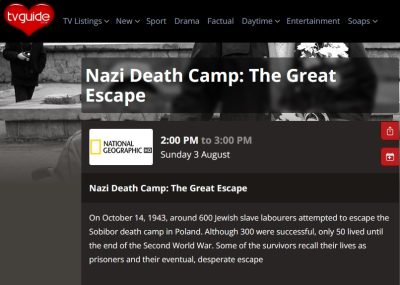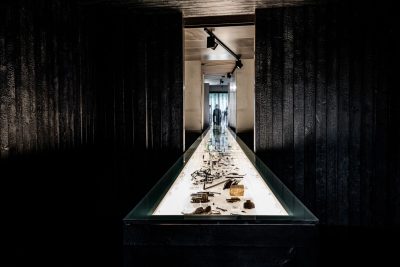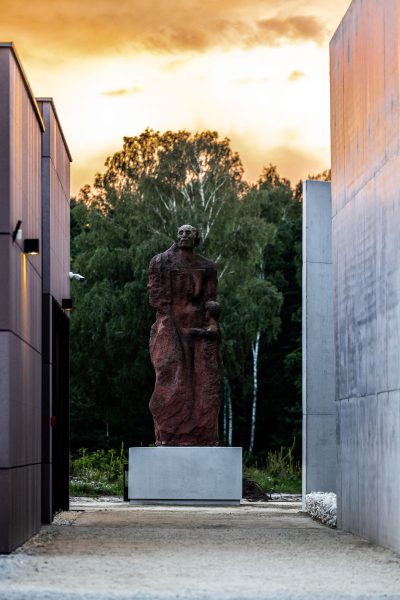The phrase "Polish death camp" is becoming less frequent in European and American media, yet the nationality of the Nazis who operated these camps is still often omitted. Furthermore, the geographical location of these camps is often misrepresented, with claims that they were situated "in Poland".
A recent example of this inaccuracy appeared on tvguide.co.uk, in a preview for the documentary “Nazi Death Camp: The Great Escape”. The documentary recounts the escape of approximately 500 Jews from the Sobibor extermination camp, located in German-occupied Poland. Of those who escaped, 300 were successful, and over 60 survived the war.
The preview’s title referred to a “Nazi death camp” located “in Sobibor, Poland,” a clear misstatement, as the camp was situated in Polish territory under German occupation.

While this might be dismissed as a minor error by a TV programme listing website, similar inaccuracies have appeared on more reputable platforms. For instance, the Holocaust Museum in Los Angeles announced in July 2025 an expansion project, including a cinema, theatre, and classrooms for students and younger audiences, as well as a new space for special exhibitions.
The museum‘s website stated: “Additionally, a new pavilion will be built on the existing building to house an authentic railcar found near the Majdanek death camp in Poland”.
It is worth recalling that several years ago, Netflix faced criticism for a map featured in the first episode of the series “The Devil Next Door,” which tells the story of Ivan Demianiuk, a Ukrainian who became a guard at the Sobibor extermination camp after being captured as a Red Army soldier by the Germans. The map showed modern-day Poland with extermination camps marked, including Auschwitz, Sobibor, and Treblinka.
This sparked outrage in Poland, as viewers unfamiliar with the history might have mistakenly associated Poland or Poles with these camps. Netflix later added a clarification to the map: “German camps in WWII occupied Poland”.
Although the term “Polish death camp” is used less frequently in European and American media, the omission of the Nazis’ nationality remains an issue. This was grotesquely evident, for example, in the Daily Telegraph’s coverage of Charles III’s visit to Auschwitz in January 2025. It was difficult to discern from the report who established the camp and who carried out the murders.
The term “Nazi” appeared only once in the entire article: “At Auschwitz, after the service, the King walked underneath the gate reading Arbeit Macht Frei – that great lie of the Nazi regime – and saw the stacks of shoes and suitcases taken from prisoners as they arrived.”
The words “German(y)” were used twice. Once, when the author listed the official guests, including the then-German Chancellor Olaf Scholz. The second time was when recounting the memories of Tova Friedman, who was sent to the camp and witnessed “all my little friends being rounded up and driven to their deaths.”
„Loaded into a cattle car with her mother, arriving at Auschwitz »with a sky obscured by smoke and a terrible stink hanging in the air«, she recalled rows of naked women and the »gleam of the German shepherd’s teeth and their eyes«: dogs the same height as her, that fear never forgotten”
ih
History of the Sobibor Camp
The German Nazi extermination camp at Sobibor was established between April and May 1942. The camp was initially divided into three sections, which included barracks for SS personnel and guards from the SS- Wachmannschaften formations, as well as facilities for Jewish prisoners.
Additionally, warehouses were constructed to store the belongings confiscated from the Jews brought to the camp. In a separate area known as Camp III, a gas chamber was built, where victims were killed using carbon monoxide produced by an engine, mirroring the method used at the Bełżec extermination camp.

Museum of the Former Death Camp in Sobibór
Throughout its operation, the camp was staffed by 51 Germans and Austrians, supported by a guard company consisting of 120 to 150 men,primarily former Soviet prisoners of war.
The first transports to the camp likely arrived at the end of March or early April 1942. By May of that year, a systematic extermination process began, lasting until the end of June. Jews from various German-occupied regions of Poland were transported to the camp, alongside arrivals from Austria, Germany, the Czech lands, and Slovakia.
Initially, the gas chambers were housed within a wooden barrack. However, between June and September 1942, they were completely reconstructed into a brick building with eight rooms, connected to two engines that pumped lethal gas, with the killing process lasting approximately 20 to 30 minutes. Prior to being led into the gas chambers, women had their hair cut off in a designated barrack situated along the path to the chambers.
A select group of Jewish prisoners (numbering between 600 and 700 men and women) were forced to work in the camp. Some were tasked with burying the bodies of the murdered, while others sorted through the victims’ belongings or served the SS and guard staff. Regular selections were conducted among these prisoners, with those who were killed being
replaced by new arrivals.

Museum of the Former Death Camp in Sobibór
Initially, the bodies of the murdered were buried n mass graves in Camp III. However, in late autumn 1942, the practice of cremating bodies commenced at Sobibor and continued until the camp’s closure. The bodies were incinerated on grates constructed from railway tracks.
It is estimated that approximately 180,000 Jews were murdered at the Sobibor extermination camp, with more than half being Polish Jews. The remainder comprised citizens from various European nations occupied by the Third Reich. While transport lists recorded the names of victims from Western Europe, no such records were maintained for Polish or Belarusian
Jews deported to Sobibor.

Museum and Memorial in Sobibor
In the summer of 1943, a group of prisoners began organising resistance in anticipation of the camp’s potential liquidation. Preparations for the uprising intensified when a group of Jewish Soviet POWs was selected from a transport arriving from Minsk, whose military experience provided hope for a successful revolt. The resistance movement was led by two individuals: Leon (Lejb) Feldhendler, representing the so-called “old prisoners”—mainly Polish Jews—and Alexander Pechersky, who led the
group of Soviet POWs.
On October 14, 1943, an uprising erupted within the camp. After killing several SS members and guards, a significant number of prisoners managed to escape although the revolt did not extend to Camp III. By the end of the war, only 50 individuals from the group of rebels had survived.
Following the uprising, the Germans resolved to dismantle the camp, employing Jewish prisoners transferred from the Treblinka extermination camp to deconstruct the barracks and gas chambers. After completing this task, these workers were executed.
Based on the website Museum and Memorial in Sobibór
Museum website in English: https://www.sobibor-memorial.eu/en

COMMENTS